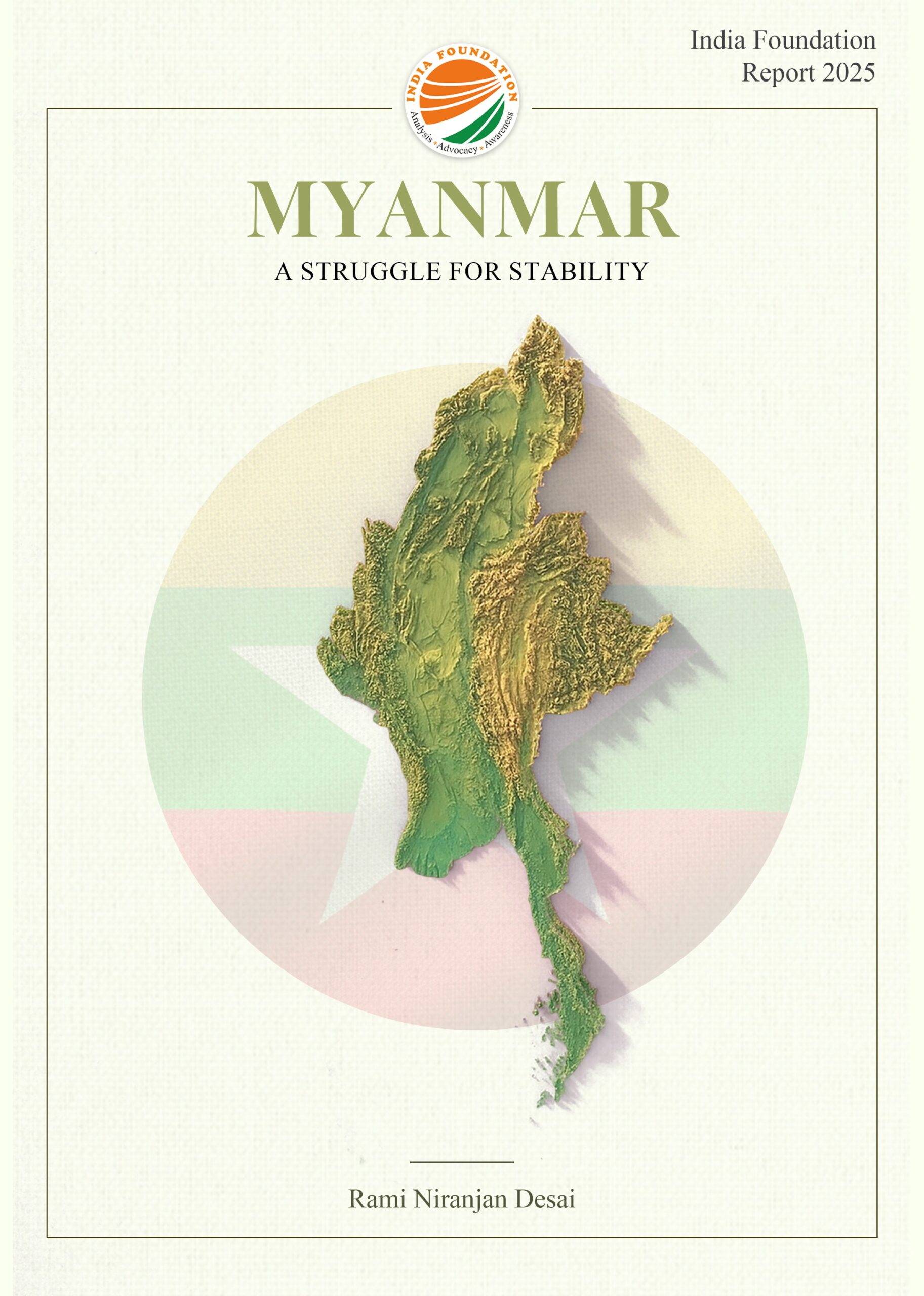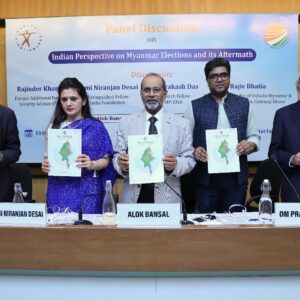
The third edition of the India Foundation Legal Dialogue took place on 26 September 2025 at the India Foundation Office, India Habitat Centre, New Delhi. The discussion centred on Article 142 of the Indian Constitution. It featured addresses by Justice Hemant Gupta, former Justice of the Supreme Court of India, and Mr Biswajit Dubey, Additional Advocate General.
The discussion was triggered by a ruling of the Apex Court in which, in exercise of its powers under Article 142 of the Constitution, the Supreme Court, in the case of the State of Tamil Nadu vs Governor of Tamil Nadu 2025, invoked Article 142 to treat 10 bills withheld by the Governor of Tamil Nadu as having received assent. The court found the Governor’s inaction and actions unconstitutional, including reserving the bills for the President a second time after the state legislature had re-passed them. This ruling used the Supreme Court’s power to do “complete justice” and set a precedent for Governors to act on bills within a reasonable timeframe, establishing that they cannot indefinitely delay or block bills after they have been re-passed by the legislature. A time limit was also imposed on the President to decide on the bills reserved for his consideration by the Governor within a period of three months from the date on which such reference is received.
Article 142 grants the Supreme Court powers to deliver complete justice. In light of the Supreme Court’s decision, there has been significant public and legal scrutiny of the judgment. The legal intricacies of this decision were examined alongside its more constitutional repercussions. The interaction of the Court’s exercise of these extraordinary powers with Articles 141, 200, 201, and 361 of the Constitution was also discussed.
It was observed that Article 142 has long held a special status within India’s constitutional framework. Unlike Article 141, which codified the binding nature of the declarations of law made by the Supreme Court, Article 142 grants the Court the authority to pass such a decree or make such an order as it deems necessary to achieve complete justice in any cause or matter before it. The framers designed this broad, open-ended phrase to give the Supreme Court an unprecedented constitutional tool for addressing situations in which strict interpretation of statutory law may not yield a just outcome. Over time, the Court has applied Article 142 in various contexts: family law, criminal justice, service issues, and most recently, high-stakes constitutional cases involving relations between the state and other entities.
During the discussion, it was observed that the recent Tamil Nadu case marked a pivotal moment in the modern constitutional history of Article 142. The Governor had refused to approve several bills passed by the state legislature, repeatedly delaying their approval, and some had been reintroduced after being returned. Subsequently, some bills were bypassed by the President without following the constitutional process. This led to a constitutional deadlock that persisted for a significant period, effectively hindering the functioning of both the state legislature and the executive. The Supreme Court intervened and declared that the reservation of ten bills for the President’s assent by the Governor was “illegal and liable to be set aside”. The exercise of judicial power has been widely debated since the Court ventured into an area traditionally considered a constitutional domain of the Governor and the President.
The differences between Articles 141 and 142, both in writing and in application, were discussed in detail. The fact that Article 141 serves as the Court’s law-declaring function was emphasised. When the Supreme Court interprets the Constitution or a statute, its pronouncements are in rem and binding on all courts and powers throughout the country. This ensures consistency and predictability in the law. Conversely, Article 142 is not a law-declaring provision. It grants the Court authority to shape relief between the parties and administer it within the case to achieve complete justice. Orders made under Article 142 are inter partes binding but do not necessarily serve as precedent. The two provisions occupy distinct yet complementary constitutional roles. Article 141 provides the overarching legal framework, while Article 142 serves as a judicial safety valve—a tool for exceptional cases where the existing law may not deliver fair outcomes.
This distinction was discussed through landmark judgments of the court. In Supreme Court Bar Association v. Union of India, 1998, it was stated that Article 142 may not be invoked to replace substantive law in a way that produces impermissible effects. A Constitution Bench held that the Court’s powers under Article 142 are supplementary and must operate within the constitutional framework. In P. Ramachandra Rao v. State of Karnataka, 2002, a case decided by a seven-judge bench, it was reaffirmed that under Article 142, they could not create legislation by imposing time limits on criminal proceedings, as these rightly form part of the legislative process. These cases reflect the consistent judicial stance: Article 142 is a powerful tool, but it does not authorise the making of laws.
The range of cases in which Article 142 has been applicable throughout history was also discussed. The Supreme Court has frequently invoked Article 142 to annul marriages before the standard time period to facilitate reconciliation, ensuring that ongoing and contentious cases are resolved. Article 142 has been drafted to provide relief in extraordinary circumstances involving service and labour issues. A notable case is State of Punjab & Others vs Rafiq Masih (White Washer) 2014, where the Court relied on Article 142 to prevent employees from being deprived of fair recovery of excess salary payments made in good faith. Additionally, Article 142 has been utilised in criminal law remission cases involving administrative or constitutional inaction. In the case of A.G. Perarivalan v. State of Tamil Nadu 2022, despite no change to the legal framework for remission, the individual petitioner was granted justice through forward remission recommendations, relying on Article 142.
In this jurisprudential context, the Tamil Nadu case was examined in detail. Paragraphs 432 and 433 of the judgment were referenced in the discussion, in which the Supreme Court explained its ruling, stating that assent had been granted under Article 142. As noted, the Court’s reasoning was cautious and deliberate. The Court concluded that the Governor committed clear constitutional violations, since the Governor’s assent alone was the only action permitted by the Constitution. The Court invoked Article 142 to resolve the persistent legislative deadlock. Notably, the Court clarified that its order was not intended to establish a general rule for all similar future cases, but applied solely to the specific situation in which it was issued. The participants affirmed that this was a prudent application of Article 142—a measure necessary to uphold constitutional governance and judicial restraint.
Much was discussed about the effects of this decision on the federal structure and the separation of powers. Participants noted that the flexibility of Article 142 enables the judiciary to act effectively when constitutional actors are unable to perform their duties, thereby preventing constitutional paralysis. Others cautioned that the broad application of Article 142 might lead to confusion between judicial roles and those of the executive or the legislature, raising concerns of overreach. It was emphasised that the legitimacy of powers granted by Article 142 largely depends on the Court’s precise definition of its limits and the exceptional nature of the circumstances.
The discussion also covered the placement of Articles 141 and 142 within the Constitution. The placement of Article 142 after Article 141 was deemed significant. This sequence shows that Article 142 does not alter the law established by Article 141; instead, it acts as a supplement. It does not replace but fills the gaps left by broader legal rules. Jurisprudence from the Supreme Court Bar Association and the P. Ramachandra Rao cases was cited to support this view. Article 142 operates within the overall constitutional framework and must be used in accordance with public policy, federal principles, and the doctrine of basic structure.

They then proceeded to consider the pending constitutional issues left to be decided by the Supreme Court under Article 143. These include whether the Governors and Presidents may have timelines imposed on them by the courts, whether actions taken before assent by a Governor can be subject to judicial review, and whether Article 142 could be used as a substitute for constitutionally assigned roles of Governors and Presidents. It was noted that the Court’s future advisory opinion on such questions would likely define the boundaries of Article 142’s use in federal disputes for many years to come. Although limited to factual circumstances, the Tamil Nadu judgment has successfully initiated a more inclusive constitutional discussion on the extent of judiciary intervention versus constitutional functional autonomy.
During the debate, participants emphasised the importance of judicial self-restraint. Article 142 is a unique constitutional mechanism — it grants the Supreme Court the authority to administer justice in challenging cases, but it does not mean unrestricted power. It is only legitimate when applied cautiously and sparingly. When used appropriately, Article 142 allows the Court to serve as a constitutional check-and-balance, intervening to prevent failures in governance or injustice in extraordinary circumstances. However, if overused, it could threaten the stability of the three branches of government. Additionally, it was noted that courts have procedural timelines—such as those described as “shall” or “may complete”—which are not always strictly followed, making case applications dependent on specific circumstances, much like other constitutional functionaries.
After an extensive discussion, the roundtable identified several issues. To begin with, Article 142 and Article 141 should be properly distinguished both theoretically and practically. The former is case-specific and may act between the parties, whereas the latter is law-declaring and may act in rem. Second, Article 142 is an additional power to act within constitutional limits and is guided by precedent and social policy. Third, although Article 142 may be important in resolving extraordinary constitutional stalemates, as in the case of Tamil Nadu, its application should be limited to such situations. Lastly, the impending presidential referendum is likely to shed much-needed light on how Article 142 may be applied concerning authority, timeframes, and the judicial replacement of constitutional roles.
The Tamil Nadu ruling has thus become a reference point in examining the role of Article 142 in the Constitution of India. It illustrates the potential and limits of judicial authority in upholding constitutional governance. As discussed, Article 142 is not a legislative instrument or a constitutional override. It is a provision designed to prevent justice from being bypassed through procedural gaps, administrative negligence, or exceptional circumstances. It is not only about the scope of its powers but also about the discipline with which it is exercised.




